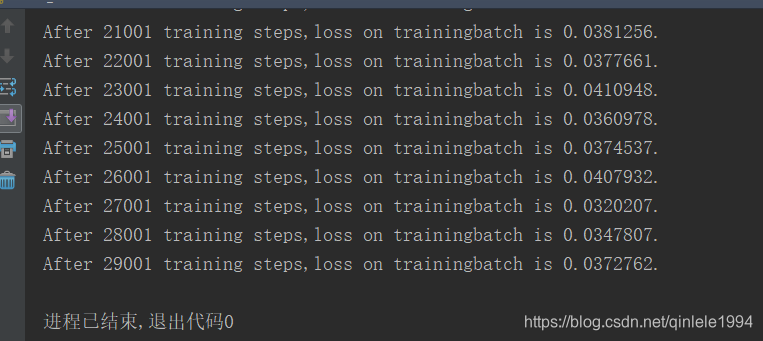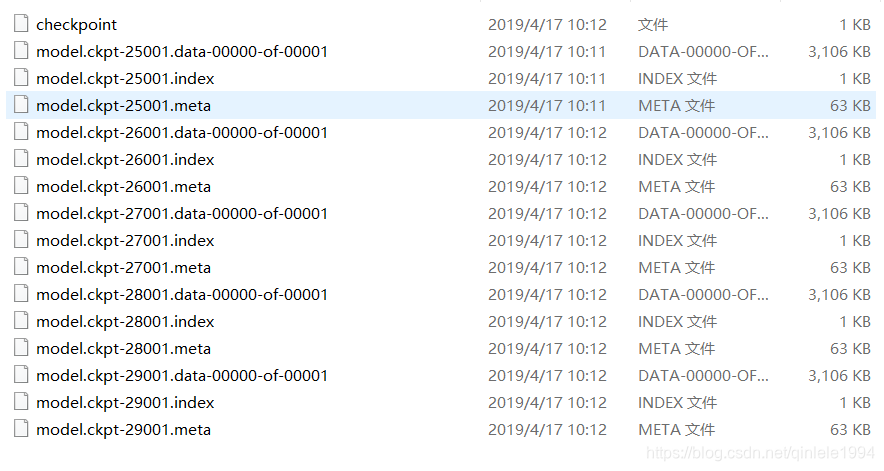MNIST数字识别问题
1、mnist_inference.py
定义了神经网络中的参数设置 W 、前向传播过程
import tensorflow as tf
INPUT_NODE = 784
OUTPUT_NODE = 10
LAYER1_NODE = 500
"""
函数功能:创建一个shape形状的变量矩阵 W 权重 ,
并将这个变量的正则化算是加入 losses 集合中
"""
def get_weight_variable(shape,regularizer): #regularizer:正则化损失函数 L1 或 L2
weights = tf.get_variable("weights",shape,initializer=tf.truncated_normal_initializer(stddev=0.1))
if regularizer != None:#如果存在正则化函数
tf.add_to_collection('losses',regularizer(weights))#那么把变量的正则化加入losses的集合中
return weights
"""
函数功能:定义神经网络的前向传播过程
传入 x regularizer正则化损失函数
"""
def inference(input_tensor,regularizer):
with tf.variable_scope('layer1'): #隐藏层
weights = get_weight_variable([INPUT_NODE,LAYER1_NODE],regularizer) #定义了变量w 并正则化损失传入 losses 集合中
biases = tf.get_variable("biases",[LAYER1_NODE],initializer=tf.constant_initializer(0.0))
layer1 = tf.nn.relu(tf.matmul(input_tensor,weights)+biases)
with tf.variable_scope('layer2'): #输出层
weights = get_weight_variable([LAYER1_NODE,OUTPUT_NODE],regularizer)
biases = tf.get_variable("biases",[OUTPUT_NODE],initializer=tf.constant_initializer(0.0))
layer2 = tf.matmul(layer1,weights)+biases
return layer2
2、mnist_train.py
定义了神经网络的训练过程
import os
import tensorflow as tf
from tensorflow.examples.tutorials.mnist import input_data
import mnist_inference
#配置神经网络中的参数
BATCH_SIZE = 100 #一次训练需要的样本点个数
REGULARAZTION_RATE = 0.0001 #正则化损失系数
def train(mnist):
#为x y_开辟空间
x = tf.placeholder(tf.float32,[None,mnist_inference.INPUT_NODE],name='x-input')
y_ = tf.placeholder(tf.float32,[None,mnist_inference.OUTPUT_NODE],name='y-input')
#正则化损失函数 系数为 0.0001
regularizerl2 = tf.contrib.layers.l2_regularizer(REGULARAZTION_RATE)
#y = (x w1) w2
#使用定义好的前向传播函数,返回输出结果 y 并将正则化损失函数放到集合中
y = mnist_inference.inference(x,regularizerl2)
# 存放训练轮数
global_step = tf.Variable(0,trainable=False)
# 定义滑动平均函数 给所有变量使用滑动平均函数
variables_averages = tf.train.ExponentialMovingAverage(0.99,global_step)
variables_averages_op = variables_averages.apply(tf.trainable_variables())
#交叉熵 :判断一个输出向量和期望的向量的接近程度 也就是两个概率分布之间的距离
cross_entropy = tf.nn.sparse_softmax_cross_entropy_with_logits(logits=y,labels=tf.argmax(y_,1))
cross_entropy_mean = tf.reduce_mean(cross_entropy)
#损失函数 loss
loss = cross_entropy_mean + tf.add_n(tf.get_collection('losses'))
#学习率
l_m_B = mnist.train.num_examples/BATCH_SIZE
learning_rate = tf.train.exponential_decay(0.8,global_step,l_m_B,0.99)
#反向传播结果
train_step = tf.train.GradientDescentOptimizer(learning_rate).minimize(loss,global_step=global_step)
#在每一次训练时 都要更新参数 和 滑动平均值 train_op
with tf.control_dependencies([train_step,variables_averages_op]):
train_op = tf.no_op(name='train')
#初始化持久化类
saver = tf.train.Saver()
with tf.Session() as sess:
tf.global_variables_initializer().run() #完成所有变量的初始化过程
for i in range(30000):
xs,ys = mnist.train.next_batch(BATCH_SIZE)
_,loss_value,step=sess.run([train_op,loss,global_step],feed_dict={x:xs,y_:ys})
if i % 1000 == 0:
print("After %d training steps,loss on training"
"batch is %g."%(step,loss_value))
saver.save(sess,os.path.join("C:/Users/asus/Desktop/TensorFlow/model/","model.ckpt"),global_step=global_step)
def main(argv=None):
mnist = input_data.read_data_sets("C:/Users/asus/Desktop/TensorFlow/mnist_data",one_hot=True)
train(mnist)
if __name__ == '__main__':
tf.app.run()
最后的结果是每训练1000轮之后,输出损失函数大小,并且保存当前模型


3、mnist_eval.py
测试代码
import time
import tensorflow as tf
from tensorflow.examples.tutorials.mnist import input_data
#加载 mnist_inference.py 和 mnist_train.py
import mnist_inference
import mnist_train
#每10秒加载一次最新的模型,并在测试数据上测试最新模型的正确率
EVAL_INTERVAL_SECS = 10
def evaluate(mnist):
#实例化一个图 并将该图作为该网络的默认图
with tf.Graph().as_default() as g:
#定义输入输出
x = tf.placeholder(tf.float32,[None,mnist_inference.INPUT_NODE],name='x-input')
y_ = tf.placeholder(tf.float32,[None,mnist_inference.OUTPUT_NODE],name='y-input')
#从测试集中读入x 和 y_
validate_feed = {x:mnist.validation.images, y_:mnist.validation.labels}
#通过调用封装好的前向传播算法,测试时候不关注正则化损失的值
y = mnist_inference.inference(x,None)
#通过对比计算正确率
correct_prediction = tf.equal(tf.argmax(y,1),tf.argmax(y_,1))
accuracy = tf.reduce_mean(tf.cast(correct_prediction,tf.float32))
#滑动平均
variable_averages = tf.train.ExponentialMovingAverage(mnist_train.MOVING_AVERAGE_DECAY)
#将滑动变量的影子值映射到变量本身
variables_to_restore = variable_averages.variables_to_restore()
#这样通过变量名加载模型的时候,就可以直接加载变量的滑动平均值
saver = tf.train.Saver(variables_to_restore)
while True:
with tf.Session() as sess:
#tf.train.get_checkpoint_state()函数自动找到目录中最新模型的文件名
ckpt = tf.train.get_checkpoint_state(mnist_train.MODEL_SAVE_PATH)
# ckpt.model_checkpoint_path表示找到的最新模型存储的位置
if ckpt and ckpt.model_checkpoint_path:
saver.restore(sess,ckpt.model_checkpoint_path)
#加载模型到会话Session中
saver.restore(sess,ckpt.model_checkpoint_path)
#通过文件名得到模型保存时迭代的轮数
global_step = ckpt.model_checkpoint_path.split('/')[-1].split('-')[-1]
accuracy_sore = sess.run(accuracy,feed_dict=validate_feed)
print("After %s training step(s),validation " "accuracy = %g"%(global_step,accuracy_sore))
else:
print('No checkpoint file found')
retun
time.sleep(EVAL_INTERVAL_SECS)
def main(argv=None):
mnist = input_data.read_data_sets("C:/Users/asus/Desktop/TensorFlow/mnist_data",one_hot=True)
evaluate(mnist)
if __name__=='__main__':
tf.app.run()








 本文详细介绍了一种基于TensorFlow的MNIST手写数字识别系统,包括神经网络的参数设置、前向传播过程、训练流程及测试代码。通过定义神经网络结构、训练模型并在测试集上评估准确率,实现了对MNIST数据集的手写数字识别。
本文详细介绍了一种基于TensorFlow的MNIST手写数字识别系统,包括神经网络的参数设置、前向传播过程、训练流程及测试代码。通过定义神经网络结构、训练模型并在测试集上评估准确率,实现了对MNIST数据集的手写数字识别。

















 被折叠的 条评论
为什么被折叠?
被折叠的 条评论
为什么被折叠?








